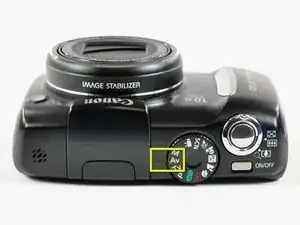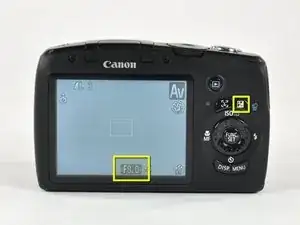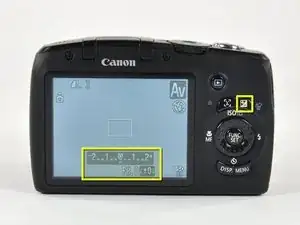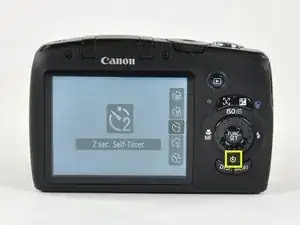Camera Operating Instructions
These instructions specifically apply to the Canon SX120IS, but the general concepts are applicable to any point-and-shoot camera.
Aperture Priority

Top of the Canon SX120IS.
The Canon Canon SX120IS has an Aperture Priority shooting mode. All photographs should be taken in this mode as it is easiest to control. You are able to adjust the aperture setting (f-stop) and exposure compensation (+/- EV) while the camera will automatically adjust the shutter speed.
(Aperture controls the amount of light let into the camera, and Aperture Priority tells the camera that you want to control that setting, and that it should automatically adjust everything else to match it.)
You should not use the flash when taking pictures of devices. Use good lights instead.
Camera Buttons

Back of the Canon SX120IS showing camera buttons.
The Canon SX120IS uses a rotary wheel around its main function buttons to change values on-screen. You can also click the rotary wheel up/down/left/right to access the ISO/timer/macro/flash functions, respectively. Other cameras may have a similar setup for accessing commons functions.
Aperture Setting (f-stop)

Changing the f-stop.
You should use the maximum f-stop setting your camera has available (not to exceed f-12.0 or so). A large f-stop keeps both the foreground and background in focus.
For the Canon SX120IS, you can change the f-stop as soon as you put the camera in Av (aperture priority) mode. Rotate the dial to change the setting. If the camera has the "adjust EV" mode on screen (covered in the next section), press the +/- button to change back to the "adjust f-stop" mode.
The camera's maximum f-stop value is 8.0, as shown in the picture.
Exposure Compensation (+/- EV)

Modifying the exposure compensation.
Click the +/- button on the top-right corner on the back of the camera to access the exposure compensation. By default it's set at 0. Setting the number higher will make the photo brighter, and lowering it will make the image darker. You should only change this setting if the pictures you're taking are coming out too dark/light. You don't have to get this perfect, because Photoshop (or similar software) can also be used in conjunction with exposure compensation to adjust the lighting of a picture.
We use exposure compensation to make the object in the picture looks appropriately lit, and then use Photoshop Elements to process the picture and make it even better. Usually, Photoshop's "Auto Levels" is sufficient, but if you have trouble with lighting you may have to do more work to make the picture acceptable. If you get stuck, try using "Adjust Lighting --> Lighten Shadows," and then adjusting "Levels" manually.
ISO

Setting the ISO.
ISO should be kept at the lowest possible value. High ISO values lead to very grainy pictures, and we like to take good-quality pictures. The ISO menu can be accessed by clicking "up" on the rotary button and then using the rotary button to change the value. In the case of the Canon SX120IS, the lowest value is 80, and that's the setting it should be set at.
What is a grainy photo? Take a look here. Notice how the parts of the photo that should be black have grey speckles in them? That's grain, and it's bad. Add more lights and reduce the ISO.
Self-Timer

Canon SX120IS's 2-second timer.
Both small ISO values (80) and large f-stops (8 or above) slow down the shutter speed. Using a timer compensates for this problem, since even the small act of pressing the shutter button will cause the image to be slightly blurry. Click "down" on the rotary button and select the 2-second timer. Other cameras may have 2- or 10-second timers; either one can be used.
(The shutter speed is the amount of time that the camera records the photo using its sensor. Think of a helicopter rotor-- if you want to take a shot of the rotor looking like it's still, you have to have a very short shutter time.)
Macro Mode

Setting the macro mode on the Canon SX120IS.
Macro mode is identified on most cameras by a "flower" icon. Sometimes it's a setting on the back of the camera (as in the Canon SX120IS), and sometimes it can be part of the rotary wheel on the top of the camera. Use the macro mode when you want to take closeups of objects. For most of the project work you can use macro mode, since the mode functions well from anywhere between 0.5" to 1.5 feet away from the object. You can certainly determine which mode (macro or normal) works better by taking a couple of test photos. Access the macro setting by clicking "left" on the rotary button.
Editing Software
We can't help you learn how to use editing software, but here are some decent online tools. DO NOT add markup (circles, rectangles, arrows, etc.) in these tools. Use our online editor for that.
Full Featured
- Photoshop Elements (Mac+Win, $65 for students)
- GimpShop (Mac+Win+Linux, Free)
Lightweight
- Picasa (Mac+Win+Linux, Free)
- iPhoto (Mac)
- Photoscape (Win, Free)